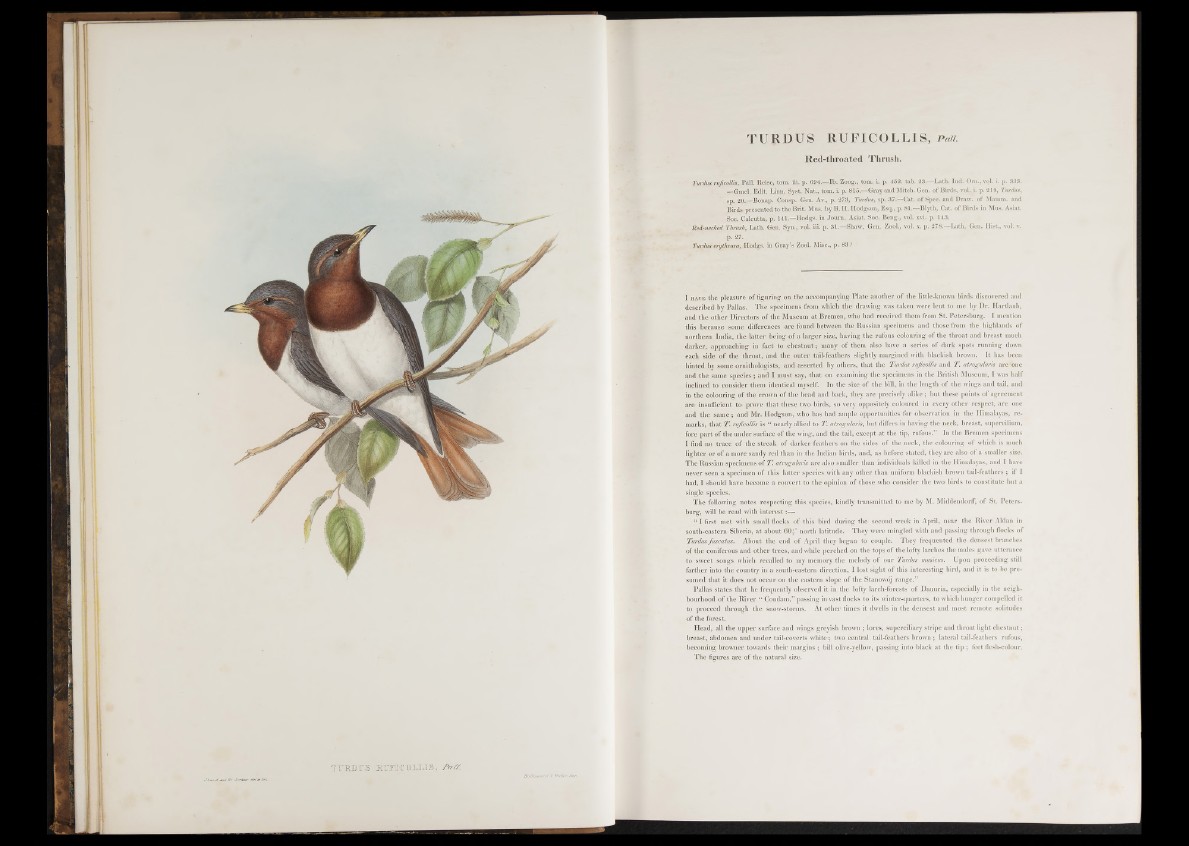
TO&jDr.S S l S l i ©LILIS-, WM&
TURDUS RUFICOLLIS, Pali.
Red-throated Thrush.
Turdus ruficollis, Pall. Reise, tom. iii. p. 694.— Ib. Zoog., tom. i. p. 452. tab. 23.—Lath. Ind. Oru.,vol. i. p. 333.
—Gmel. Edit. Linn. Syst. Nat., tom. i. p. 315.—Gray and Mitch. Gen. o f Birds, vol. i. p. 219, Turdus,
Sp. 20— Bonap. Consp. Gen. Av., p. 273, Turdus, sp. 37.—Cat. of Spec, and Draw, of Mamm. and
Birds presented to the Brit. Mus. by B. II. Hodgson, Esq., p. 81.—Blytb, Cat. o f Birds in Mus. Asiat.
Soa Calcutta, p. 1 4 1—Hodgs. in Joum. Asiat. Soc, Beng., vol. xvi. p. 143.
Red-necked. Thrush, Lath. Gen. Syn., vol. iii. p. 3 1—Shaw, Gen. Zool., vol. x. p. 278.— Lath. Gen. Hist., vol. v.
p. 27.
Turdus erythrura, Hodgs. in Gray’s Zool. Misc., p. 83 ?
I have the pleasure o f figuring on the accompanying Plate another o f the little-known birds discovered and
described by Pallas. The specimens from which the drawing was taken were lent to me by Dr. Hartlaub,
and the other Directors o f the Museum at Bremen, who had received them from St. Petersburg. I mention
this because some differences are found between the Russian specimens and those from the highlands of
northern India, the latter being o f a larger size, having the rufous colouring o f the throat and breast much
darker, approaching in fact to chestnut; many o f them also have a series o f dark spots running down
each side o f the throat, and the outer tail-feathers slightly margined with blackish brown. It has been
hinted by some ornithologists, and asserted by others, that the Turdus ruficollis and T. atrogularis are one
and the same sp e c ie s; and I must say, that on examining the specimens in the British Museum, I was half
inclined to consider them identical myself. In the size o f the bill, in the length o f the wings and tail, and
in the colouring o f the crown o f the head and back, they are precisely alike; but these points o f agreement
are insufficient to prove that these two birds, so very oppositely coloured in every other respect, are one
and the sam e ; and Mr. Hodgson, who has had ample opportunities for observation in the Himalayas, remarks,
that T. ruficollis is “ nearly allied to T. atrogularis, but differs in having the neck, breast, supercilium,
fore part o f the under surface o f the wing, and the tail, except at the tip, rufous.” In the Bremen specimens
I find no trace o f the streak o f darker feathers on the sides o f the neck, the colouring o f which is much
lighter or o f a more sandy red than in the Indian birds, and, as before stated, they are also o f a smaller size.
The Russian specimens o f T. atrogularis are also smaller than individuals killed in the Himalayas, and I have
never seen a specimen o f this latter species with any other than uniform blackish brown tail-feathers ; if I
had, I should have become a convert to the opinion o f those who consider the two birds to constitute but a
single species.
The following notes respecting this species, kindly transmitted to me by M. Middendorff, o f St. Petersburg,
will be read with in te r e st:—
“ I first met with small flocks o f this bird during the second week in April, near the River Aldan in
south-eastern Siberia, at about 604-° north latitude. They were mingled with and passing through flocks o f
Turdus fuscatus. About the end o f April they began to couple. They frequented the densest branches
o f the coniferous and other trees, and while perched on the tops o f the lofty larches the males gave utterance
to sweet songs which recalled to my memory the melody o f our Turdus musicus. Upon proceeding still
farther into the country in a south-eastern direction, I lost sight o f this interesting bird, and it is to be presumed
that it does not occur on the eastern slope o f the Stanowoj range.”
Pallas states that he frequently observed it in the lofty larch-forests o f Dauuria, especially in the neighbourhood
o f the River “ Gondam,” passing in vast flocks to its winter-quarters, to which hunger compelled it
to proceed through the snow-storms. At other times it dwells in the densest and most remote solitudes
o f the forest.
Head, all the upper surface and wings greyish brown ; lores, superciliary stripe and throat light ch estnu t;
breast, abdomen and under tail-coverts w h ite; two central tail-feathers brown ; lateral tail-feathers rufous,
becoming browner towards their margins ; bill olive-yellow, passing into black at the tip ; feet flesh-colour.
The figures are o f the natural size.